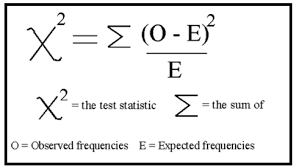In the transpiration lab, what was the problem we were trying to solve? Write a hypothesis that connects with the problem.
-What condition causes the most transpiration to occur in Pachysandras?
-If we place the plants in the four different conditions, then each plant will transpire at different rates because the environment around a plant alters transpiration rates.
Chi-Square formula?

 Which beaker(s) contain(s) a solution that is hypertonic to the bag?
Which beaker(s) contain(s) a solution that is hypertonic to the bag?
Beakers 1, 2, and 5
Chi-Square Lab Null Hypothesis
If we observe the number of M&M's then the number will not differ from the expected percentage.
What needs to be included in a good lab report?
-Hypothesis
-IV
-DV
-Constants
-Controls
-Conclusion
-Validity
-Problem Question
When writing a "conclusion" for a Chi-Square problem, what should be included?
-Formula for Chi-Square
-Degrees of Freedom calculations
-The observed values (are/are not) statistically significant since (number) (is/is not) under the (value) on the degrees of freedom chart.

3. What is the Rf value for carotene calculated from the chromatogram below?
0.96
Several factors account for the movement of water up xylem vessels. Which single factor is most important in pulling water toward the top of a tall tree?
Evaporation of water through stomata
What is the null hypothesis for the transpiration lab?
If we put four different plants under four different conditions, then they will all transpire the same amount because differing conditions do not effect transpiration rates.
What are the differences between a male and female Drosophila?
Males
- grasper
-rounded, dark abdomen
Females
-no grasper
-pointed, lighter abdomen
What type of environment would result in the greatest rate of transpiration?
Warm, light-breezy conditions
The molar concentration of a sugar solution in an open beaker has been determined to be 0.3M. Calculate the solute potential at 27 degrees. Round your answer to the nearest hundredth.
−7.48
Calculation:
Solute potential = −iCRT
= −(1) (0.3 mole/1) (0.0831 liter bar/mole K) (300 K)
−7.48

1. During what time interval is the enzyme working at its maximum velocity?
0–30 seconds
What is the null hypothesis for the enzyme lab?
If we add different amount of enzyme to the solution, then the rate of hydrogen peroxide will be the same throughout because the amount of enzyme does not effect the breakdown of H2O2.
What is the formula for calculated Rf?
pigment distance from solvent / solvent distance
Write a hypothesis for the Osmosis Lab
If we use the patient solution in different solutions we will be able to determine the different molarities of the different solutions because osmosis will cause water to flow through towards the sugar because the sugar molecules are too big to move across the tubing. The solution with the greatest molarity will cause the bag to lose the most mass.
There are two components to water potential: solute concentration and pressure. How do you think this fact affects the movement of water into and out of cells? For example, can two solutions that differ in their solute concentration be at equilibrium in terms of water movement? Can a solution with a molarity of 0.2 be in equilibrium with a solution with a molarity of 0.4?
Yes, Two solutions will be at equilibrium when the water potential is the same in both solutions.
What is the role of sulfuric acid (H2SO4) in this experiment? (Enzyme Lab)
It denatures the enzyme by altering the active site.
How should you write a null hypothesis?
If...happens, then the results will be the same, because...
What is the formula for %mass change?
%mass change= mf-mi / mi * 100
Write a conclusion for the cellular respiration lab.
As the temperature decreased the amount of cellular respiration decreased.
Germinating peas cause a higher rate of respiration.
If guard cells in a plant were deficient in K+, which of the following would be most likely to occur?
a.Wilting would become more likely.
b.Photosynthesis would decrease.
c.Transpiration would increase.
d.Food transport would decrease.
Photosynthesis would decrease.

In beaker B, what is the water potential of the distilled water in the beaker, and of the beet core?
Water potential in the beaker = 0, water potential in the beet core = −0.2
What is a null hypothesis for the photosynthesis lab?
The null hypothesis is if there are different colored lights the leaves will all photosynthesize at the same rate because the color of the light does not matter.
https://docs.google.com/spreadsheets/d/10isZWo5-PlAWwjqCiTd2C_wFIhVvGETM6w_z3UrPemc/edit#gid=0
Create a Graph with the proper elements.
Name the important elements of a good graph.
-title
-Independent/Dependent Variable (Labels)
-Proper spacing
-Proper values